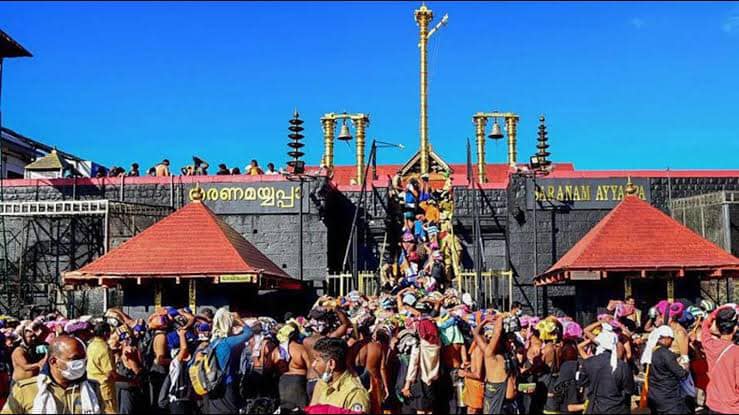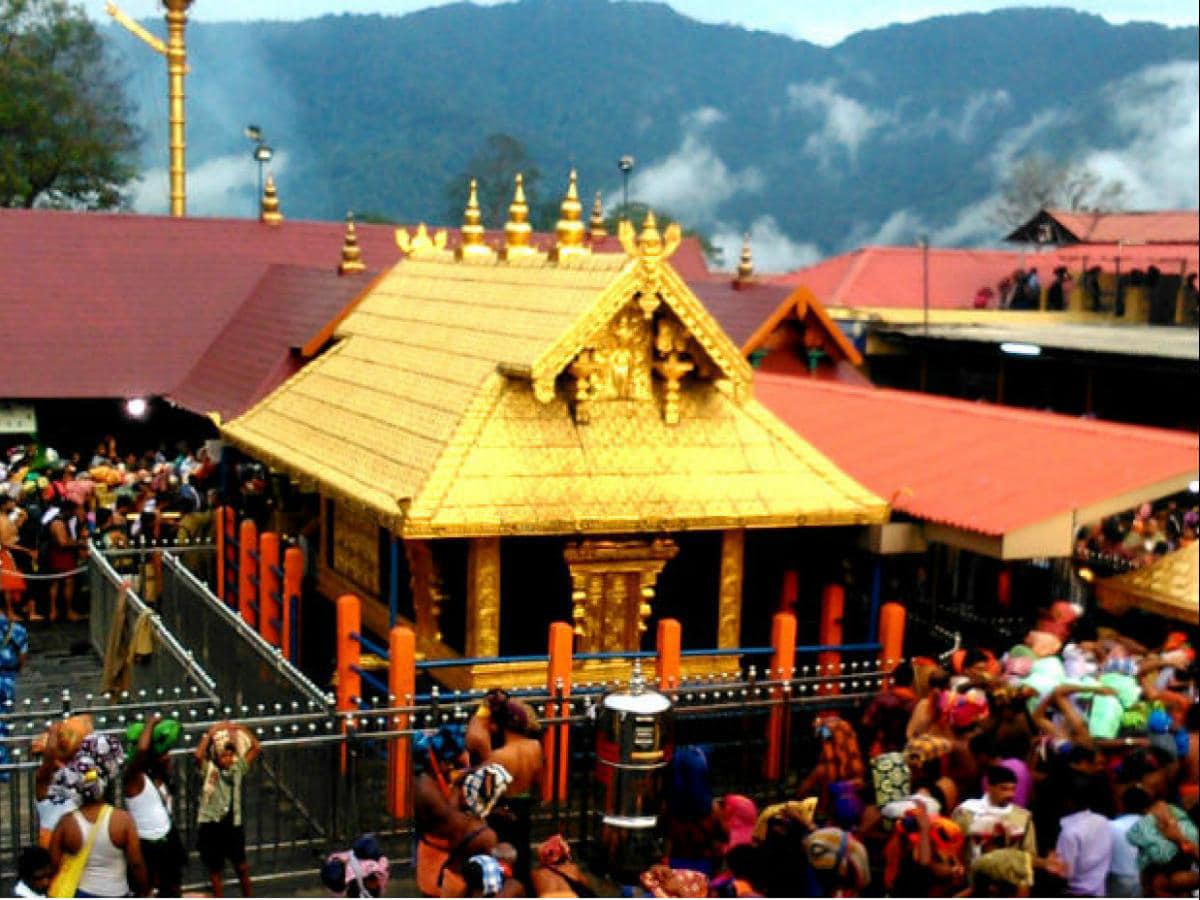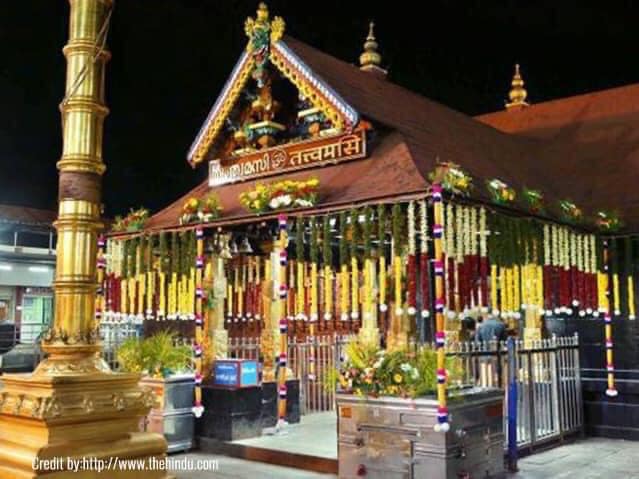Sabarimala shrine is a historic temple. It is thought that the prince of the Pandalam dynasty, who is considered an incarnation of Ayyappan, engaged in meditation at the Sabarimala temple.

Sabarimala Sree Dharma Sastha Temple is located on the summit of Sabarimala hill in the village of Ranni-Perunad, which is part of the Ranni Taluk in the Pathanamthitta district of Kerala, India. It is encircled by 18 hills within the Periyar Tiger Reserve.
This site ranks among the largest annual pilgrimage destinations globally, attracting an estimated 10 to 15 million devotees each year. The temple is accessible for worship exclusively during the Mandala Pooja period (approximately from November 15 to December 26), Makaravilakku or Makara Sankranti (January 14), Maha Thirumal Sankranti (April 14), and the initial five days of each Malayalam month. Sabarimala Temple exemplifies the integration of various religious traditions within the Indian cultural landscape.
The temple's practices include a restriction that prohibits women aged between 10 and 50 years from entering the temple grounds. The Bhagavata Purana narrates that the deity Shiva developed an affection for the deity Vishnu when Vishnu assumed his female incarnation, Mohini. This union led to the birth of the deity Shasta, who is also referred to as Hariharaputra, signifying the son of Hari (Vishnu) and Hara (Shiva). It is commonly believed that Ayyappa is an incarnation of Shasta.
The veneration of Shasta is deeply rooted in the ancient traditions of South India. Numerous temples dedicated to Shasta can be found throughout South India and in various locations worldwide. Five temples dedicated to Shasta, located in Kulathupuzha, Aryankavu, Achankovil, Sabarimala, and Ponnambalmedu, are believed to have connections to Parashurama, an incarnation of Vishnu. In Kulathupuzha, Shasta is revered as a child deity. The Aryankavu temple depicts him as a young Brahmachari.
The Achankovil temple illustrates the deity in his Grihastha phase, where he is portrayed seated on a horse, wielding a sword, accompanied by his consorts, Pushkala and Poorna. The Sabarimala temple represents the deity's Vanaprastha stage, while in the Ponnambalmedu or Kantamala temple, he is depicted as the supreme Yogi. Sage Suta recounted to his disciples the narrative of Ayyappa's birth, as detailed in the Bhutnathopakhyanam, a revered text among Ayyappan devotees. Following Chamundi's defeat of Mahisasura, his sister Mahisi sought vengeance against the gods. In response, Brahma granted Mahisi a boon that rendered her invulnerable, with the stipulation that only a human born of two males could vanquish her.
The gods, feeling fearful and powerless, turned to Vishnu for aid. The convergence of Shiva and Vishnu, who assumed the form of Mohini, resulted in the birth of a son named Manikandan. Manikandan was left on the banks of the Pampa River in southern India. The child was discovered by Emperor Rajasekhara of the Panthalam dynasty, who was childless at the time. Shortly thereafter, the queen gave birth to a child but harbored animosity towards Manikandan, plotting to eliminate him. She feigned illness, asserting that her only remedy was tiger's milk. In a courageous act, twelve-year-old Manikandan ventured into the wilderness to procure the milk for his mother.
During his expedition, he vanquished Mahishi, which delighted the devas. Indra then took on the form of a tiger, which Manikandan utilized to return to the kingdom. He shot an arrow into the forest to indicate the site for a temple, instructed them to build it, and subsequently ascended to Devaloka, the realm of the devas. Connection with Rama
Shabari, a devoted tribal follower of Rama, is a notable figure in the Ramayana. The term Sabarimala translates to "the hill of Sabari."
According to legend, Shabari encountered Sage Matanga at the base of Mount Rishyamukha, who became her spiritual teacher. She dedicated many years to serving him. As he lay on his deathbed, Sage Matanga prophesied that Rama would come to bestow his divine presence upon her and instructed her to await his arrival. Since that moment, Shabari ventured from her ashram each day solely to collect berries for Rama. She would taste each berry, placing only the sweet ones in her basket while discarding the bitter ones, as she wished to offer Rama only the finest. During his quest for Sita, Rama visited Shabari at her ashram, where she graciously offered him the berries she had gathered.
Rama, noticing a divine figure engaged in penance, inquired of Shabari about the identity of this person. She informed him that it was Sastha (Ayyappan), who then rose and greeted Rama.
The Sannidhanam, or main temple, is situated on a plateau approximately 40 feet in height.
This temple features a sanctum sanctorum topped with a gold-plated roof and adorned with four golden finials. It also includes two mandapams and the balikalpura, which contains the altar.
The primary access to the temple is through the 18 sacred steps. According to tradition, no pilgrim is permitted to ascend these steps without the "Irumudikkettu."
In 1985, these steps were covered with Panchaloha. The temples dedicated to Ayyappan's loyal attendants, Karuppu Sami and Kadutha Sami, are positioned at the base of the 18 sacred steps, serving as guardians.
The northern gate is accessible to individuals without an "Irumudikkettu," as established by a 1991 ruling from the Kerala High Court.
To the southwest of the sanctum lies the shrine of Ayyappan's half-brother, Ganesha. Devotees traditionally offer a portion of a broken coconut (Neythenga) to the fireplace (Azhi), with Ganapati homam being the principal offering.
Located just a short distance from Sannidhanam is the temple of Maalikapurathamma, which holds significance nearly equal to that of Ayyappan. It is believed that Ayyappan specifically requested that Malikappurath Amma be positioned to his left. Before the fire disaster, only a Peeda Prathishta (holy seat) existed at Malikappuram. The idol of Malikappurath Amma was installed by Brahmasree Kandararu Maheswararu Thanthri. The deity is depicted holding a Sankh, Chakram, and Varada Abhya Mudra, and the idol is now encased in a gold golaka. The temple underwent reconstruction in the past decade, with its conical roof and sopanam now also covered in gold.
The shrine dedicated to Nagaraja, the king of the snakes, is located next to the Malikappurathamma temple. After completing their darshan of Ayyappa and Kannimoola Ganapathi, pilgrims proceed to pay their respects and offer gifts to Nagaraja.
Manimandapam is recognized as the site where Ayyappan is believed to have disappeared into the temple.
The Sabarimala temple complex encompasses several significant temples, including Pampa Ganapathi temple, Nilakal Mahadeva temple, and Palliyarakkavu Devi Temple. Both the Nilakal Mahadeva temple and Palliyarakkavu Devi Temple are as ancient as the Ayyappan temple, with the deities revered as Ayyappan's parents.
The Ganapathi temple at Pampa features idols of Pampa Maha Ganapathi and Athi Ganapathi (translated as old Ganesha); within the Sreekovil, the idol from the original Ganesha temple is venerated. Additionally, Sabari Peedam houses a temple dedicated to Rama and Hanuman. The offerings at the Sabarimala temple include Aravana payasam and Appam. An 'Appam' is a sweet delicacy made from rice, kadalippazham, and ghee, while 'Aravana' denotes a rich and sweet dessert. The Chief Commissioner of the Travancore Devaswom Board announced that the board has been designated by the Central Food Technological Research Institute in Mysore to serve as a consultant, providing technical expertise to guarantee the quality of Aravana, Appam, and other prasadam preparations at the Sabarimala temple.
This important ceremony entails the offering of sacred ghee, which is carried by pilgrims in their Pallikettu or Irumudi—a two-compartment bag crafted from handwoven cotton cloth, used to transport offerings to the Sabarimala Temple, balanced on their heads—onto the idol of Ayyappan. This act symbolically represents the union of the individual soul (Jeevatma) with the supreme soul (Paramatma).
Makara Vilakku
Makaravilakku is a yearly celebration that takes place on Makara Sankranti in Kerala, India, at the Sabarimala shrine. The festival features the Thiruvabharanam, which is the procession of the sacred ornaments belonging to the deity Ayyappan, along with a gathering at the hilltop shrine. Each year, approximately half a million devotees visit Sabarimala to witness this significant ritual. The length of the pilgrimage to the Sabarimala temple is fixed. Additionally, pilgrims must complete different phases of the pilgrimage in a specific sequence.
The journey to Sabarimala commences on the initial day of the Vrischika month in the Malayalam calendar (corresponding to Scorpio) and concludes on the 11th day of the Dhanu month (associated with Sagittarius). This 41-day pilgrimage period is referred to as the mandala season, which occurs during December and January.
ശബരിമല ശ്രീ ധർമ്മശാസ്താ ക്ഷേത്രം
കേരളത്തിലെ പത്തനംതിട്ട ജില്ലയിൽ, റാന്നി താലൂക്കിലെ റാന്നി-പെരുനാട് ഗ്രാമപഞ്ചായത്തിൽ, പശ്ചിമഘട്ടത്തിന്റെ ഭാഗമായ പെരിയാർ കടുവ സംരക്ഷിത പ്രദേശത്ത് സ്ഥിതിചെയ്യുന്ന ശബരിമല ശ്രീ അയ്യപ്പക്ഷേത്രം, അല്ലെങ്കിൽ ശബരിമല ശ്രീ ധർമ്മശാസ്താ ക്ഷേത്രം, ഒരു പ്രധാന ഹൈന്ദവ തീർത്ഥാടന കേന്ദ്രമാണ്. ലോകത്തിലെ ഏറ്റവും വലിയ ക്ഷേത്രങ്ങളിലൊന്നായ ശബരിമല, പ്രത്യേക കാലഘട്ടങ്ങളിൽ ഏറ്റവും കൂടുതൽ ഭക്തരെ ആകർഷിക്കുന്നു. ഓരോ വർഷവും ഇവിടെ ഏകദേശം മൂന്നു കോടിയിലധികം ആളുകൾ സന്ദർശിക്കുന്നു, ചില കണക്കുകൾ പ്രകാരം ഇത് അഞ്ചു കോടിയോളം ആളുകൾക്കു വരെ എത്തുന്നുവെന്ന് പറയുന്നു.
ഹരിഹരപുത്രനായ അയ്യപ്പനാണ് (ധർമ്മശാസ്താവ്) ഇവിടെ പ്രധാന പ്രതിഷ്ഠയായി വിശ്വസിക്കപ്പെടുന്നത്. കൂടാതെ, സമീപത്തെ ക്ഷേത്രത്തിൽ മാളികപ്പുറത്തമ്മ എന്ന പേരിലുള്ള ശക്തിസ്വരൂപിണിയായ ഭഗവതി സങ്കല്പം ഉണ്ട്. ആദിമൂല ഗണപതി, മഹാദേവൻ, വലിയ കടുത്തസ്വാമി, കൊച്ചു കടുത്തസ്വാമി, കറുപ്പുസ്വാമി, നവഗ്രഹങ്ങൾ, നാഗദൈവങ്ങൾ എന്നിവയ്ക്ക് പ്രത്യേക സന്നിധികൾ ഉണ്ട്. ശബരിമലയിലെ ആചാരങ്ങൾ ശൈവമതം, വൈഷ്ണവമതം, ശാക്തേയം, ശ്രമണമതം എന്നിവയുടെ സംയോജനം ആണ്. വേദവാക്യങ്ങളിൽ ഏറ്റവും പ്രസിദ്ധമായ തത്ത്വമസി (അത് നീയാകുന്നു) എന്ന മഹാവാക്യം ഈ ക്ഷേത്രത്തിന്റെ മുന്നിൽ വലിയ അക്ഷരത്തിൽ എഴുതിയിട്ടുണ്ട്.
ശബരിമല ക്ഷേത്രം സമുദ്രനിരപ്പിൽ നിന്നും ഏകദേശം 1,260 മീറ്റർ (4,134 അടി) ഉയരത്തിൽ 18 മലകൾക്കു നടുവിലായാണ് സ്ഥിതിചെയ്യുന്നത്. ഇവിടെ പഞ്ചലോഹത്തിൽ പൊതിഞ്ഞ പതിനെട്ട് കരിങ്കൽ പടികളോടുകൂടിയ ഒരു ചെറിയ ക്ഷേത്രവും, അതിനുമുകളിലുള്ള സ്വർണ്ണം പൊതിഞ്ഞ രണ്ട് ചതുരശ്രീകോവിലുകളുമുണ്ട്. കേരളത്തിലെ മൂന്നാമത്തെ വലിയ നദിയായ പമ്പാ നദിയുടെ ഉദ്ഭവം ശബരിമലയ്ക്കടുത്താണ്. ക്ഷേത്രത്തിൽ നിന്ന് ഏകദേശം അഞ്ചുകിലോമീറ്റർ തെക്കുപടിഞ്ഞാറ് പമ്പാനദിയിൽ ഒരു സ്നാനഘട്ടം സ്ഥിതിചെയ്യുന്നു. ഇവിടെ കുളിച്ച് കുടുംബത്തിലെ മരിച്ചവരുടെ പിതൃക്കൾക്ക് ബലിയിട്ടാണ് ഭക്തർ മല ചവിട്ടുന്നത്. നാനാ ജാതിമതസ്ഥർക്കും ഇവിടെ പ്രവേശനം അനുവദനീയമാണ്, എന്നാൽ ഇരുമുടിക്കെട്ടുമായി വരുന്നവരെ മാത്രമേ 18 പടികൾ കയറാൻ അനുവദിക്കൂ.
ഈ ക്ഷേത്രത്തിലെ പ്രധാന വഴിപാട് "നെയ്യഭിഷേകമാണ്". ഈ ക്ഷേത്രം ദേവസ്വം ബോർഡിന്റെ കീഴിലാണ്. തിരുവിതാംകൂർ ദേവസ്വം ബോർഡിന് കീഴിലുള്ള ഏറ്റവും ഉയർന്ന വരുമാനമുള്ള ക്ഷേത്രമാണ് ഇത്. ഇവിടെ മറ്റ് ക്ഷേത്രങ്ങളിലെപ്പോലെ വർഷം മുഴുവൻ എല്ലാ ദിവസവും പൂജയോ തീർത്ഥാടനമോ നടക്കുന്നത് ഇല്ല. നവംബർ-ഡിസംബർ മാസങ്ങളിൽ, വൃശ്ചികം ഒന്നുമുതൽ ധനു പതിനൊന്നുവരെ നീളുന്ന 41 ദിവസത്തെ മണ്ഡലക്കാലം ശബരിമലയിലെ പ്രധാന തീർത്ഥാടനകാലയളവാണ്. ഇതിന് പുറമെ, എല്ലാ മലയാളമാസങ്ങളിലെയും ആദ്യത്തെ അഞ്ചുദിവസങ്ങളിലും സന്ദർശനത്തിന് അനുമതി നൽകുന്നു. ഇത് ആരംഭിച്ചിട്ടു കുറച്ച് കാലം മാത്രമാണ്. മീനമാസത്തിലെ ഉത്രം നക്ഷത്രത്തിൽ (പങ്കുനി ഉത്രം) ആറാട്ടായി പത്തുദിവസം ഉത്സവം ക്ഷേത്രത്തിൽ നടത്തപ്പെടുന്നു.
കൂടാതെ, വിഷു, ഓണം, വിജയദശമി, ദീപാവലി, ശിവരാത്രി തുടങ്ങിയ പ്രത്യേക ദിവസങ്ങളിലും ഇവിടെ പൂജകൾ നടത്തപ്പെടുന്നു. കുടുംബവുമായി ബന്ധപ്പെട്ട ഏറ്റവും പ്രശസ്തമായ ഐതിഹ്യമാണ് ഇത്. കുട്ടികളില്ലാതെ ദു:ഖിതനായ ശിവഭക്തനായ പന്തളം രാജാവ് രാജശേഖരപാണ്ഡ്യൻ, ഒരു ദിവസം നായാട്ടിനായി വനത്തിലേക്ക് പോയപ്പോൾ, പമ്പാ നദിയുടെ തീരത്ത് ഒരു മനോഹരനായ ബാലനെ കണ്ടു. ഈ ബാലൻ ശിവന്റെ മോഹിനിരൂപത്തിലുള്ള വിഷ്ണുവിൽ ജനിച്ച പുത്രനാണെന്ന് വിശ്വസിക്കപ്പെടുന്നു. കഴുത്തിൽ സ്വർണ്ണമണിമാല ഉണ്ടായതിനാൽ, രാജാവ് ഈ ബാലനെ “മണികണ്ഠൻ” എന്ന പേരിൽ വിളിച്ചു. ശിവപാർവതിമാരുടെ അനുഗ്രഹത്തോടെ, രാജാവ് ഈ കുട്ടിയെ രാജകൊട്ടാരത്തിലേക്ക് കൊണ്ടുപോയി. പിന്നീട്, രാജ്ഞി ഒരു ആൺ കുഞ്ഞിനെ ജന്മം നൽകുകയും ചെയ്തു.
അയ്യപ്പന്റെ അവതാരത്തെക്കുറിച്ച് നിരവധി ഐതിഹ്യങ്ങൾ നിലവിലുണ്ട്. പന്തളം രാജഅയ്യപ്പനെ യുവരാജാവായി വാഴിക്കാൻ പന്തളം രാജാവിന്റെ ആഗ്രഹം ആയോധനകലയിലും വിദ്യകളിലും അദ്ദേഹത്തിന്റെ കഴിവുകൾക്കനുസരിച്ചായിരുന്നു. എന്നാൽ, മഹാറാണി തന്റെ മകനെ യുവരാജാവാക്കാൻ തന്ത്രങ്ങൾ ഒരുക്കുകയായിരുന്നു. ഇതിന്റെ ഭാഗമായി, രാജ്ഞി മന്ത്രിയെ വശത്താക്കുകയും, കപടമായി വയറുവേദന പ്രകടിപ്പിക്കുകയും, കൊട്ടാരവൈദ്യൻ രോഗത്തിന് പുലിപ്പാൽ മരുന്നായി നിശ്ചയിക്കുകയും ചെയ്തു. ഗൂഢപദ്ധതിയുടെ ഭാഗമായി, പുലിപ്പാൽ കാട്ടിൽ നിന്നും കൊണ്ടുവരാൻ രാജകുമാരനായ മണികണ്ഠനെയാണ് നിയോഗിച്ചത്. അങ്ങനെ, പുലിപ്പാലിനായി അയ്യപ്പനെ കൊടുംകാട്ടിലേക്ക് അയക്കാൻ രാജ്ഞി തീരുമാനിച്ചു. എന്നാൽ, ലോകോപദ്രവകാരിണിയായ മഹിഷിയെ വധിച്ച്, അയ്യപ്പൻ വിജയശ്രീലാളിതനായി പന്തളദേശത്ത് മടങ്ങി എത്തുകയായിരുന്നു.
അയ്യപ്പന്റെ അവതാരത്തെക്കുറിച്ച് നിരവധി ഐതിഹ്യങ്ങൾ നിലവിലുണ്ട്. പന്തളം രാജഅയ്യപ്പൻ ദൈവമാണെന്ന് തിരിച്ചറിഞ്ഞ പന്തളം രാജാവ്, അയ്യപ്പന്റെ നിർദ്ദേശം അനുസരിച്ച് ശബരിമലയിൽ ഒരു ക്ഷേത്രം നിർമ്മിച്ചു.
പുലിപ്പാൽ കൊണ്ടുവന്നതിനായി കാട്ടിലേക്ക് പോകുമ്പോൾ “ഇരുമുടിക്കെട്ട്” എന്ന വിശ്വാസം ഉണ്ടാകുന്നു. അയ്യപ്പനോടുള്ള രാജ്ഞിയും മന്ത്രിയും ചെയ്ത പാപങ്ങളിൽ നിന്നും മോചനം നേടാൻ 41 ദിവസത്തെ വ്രതവും, വർഷംതോറും നടത്തുന്ന തീർത്ഥയാത്രയും എന്നതാണ് ഐതിഹ്യം. ജീവാത്മാവായ ഭക്തൻ, പരമാത്മാവായ ഭഗവാനെ സമർപ്പിക്കുന്ന വസ്തുവെന്ന നിലയിൽ ഇരുമുടിക്കെട്ടിനെ വിശേഷിപ്പിക്കാറുണ്ട്.
അയ്യപ്പന്റെ അവതാരത്തെക്കുറിച്ച് നിരവധി ഐതിഹ്യങ്ങൾ നിലവിലുണ്ട്. പന്തളം രാജ ശബരിമല തീർത്ഥാടനത്തിന് കൊല്ലവർഷം വൃശ്ചിക മാസത്തിലെ ഒന്നാം തീയതി ആരംഭിക്കുന്നു, ധനു മാസത്തിലെ പതിനൊന്നാം തീയതി അവസാനിക്കുന്നു. വൃശ്ചിക മാസത്തിലെ ഒന്നാം തീയതി മുതൽ ധനു മാസത്തിലെ പതിനൊന്നാം തീയതിവരെയുള്ള 41 ദിവസത്തെ ഈ തീർത്ഥാടനകാലം മണ്ഡല കാലം എന്നറിയപ്പെടുന്നു. ഡിസംബർ-ജനുവരി മാസങ്ങളിലായാണ് ഈ കാലം നടക്കുന്നത്. ശബരിമലയാത്രയ്ക്ക് മുമ്പ്, തീർത്ഥാടകർ 41 ദിവസത്തെ വ്രതം അനുഷ്ഠിക്കുന്നു. ഇതിന് മുമ്പായി, അവർ അടുത്തുള്ള ക്ഷേത്രത്തിൽ ദർശനം നടത്തി, തുളസിമുത്തുകൾ അല്ലെങ്കിൽ രുദ്രാക്ഷം ഉപയോഗിച്ച് നിർമ്മിച്ച ഒരു മുദ്രമാല ധരിക്കുന്നു. ഇതിന് ശേഷം, അവർ അയ്യപ്പൻ അല്ലെങ്കിൽ സ്വാമി എന്നറിയപ്പെടുന്നു. സ്ത്രീകൾ ആണെങ്കിൽ, അവരെ മാളികപ്പുറത്തമ്മ എന്ന് വിളിക്കുന്നു.
ഇരുമുടിക്കെട്ട്, പുണ്യവും പാപവും ഉൾക്കൊള്ളുന്ന ഒരു പ്രതീകമാണ്, അയ്യപ്പഭക്തന്മാർ മണ്ഡലകാലത്ത് തങ്ങളുടെ തലയിലേയ്ക്ക് ഉയർത്തി കൊണ്ടുപോകുന്നു. ശബരിമല തീർത്ഥാടകർ, പള്ളികെട്ട് എന്നറിയപ്പെടുന്ന ഈ കെട്ടിന്റെ സഹായത്തോടെ ശബരിമലയിലേക്കുള്ള പൂജാദ്രവ്യങ്ങൾ കൊണ്ടുപോകുന്നു. ഭക്തർ ഈ ഇരുമുടിക്കെട്ടുമേൽ മലചവിട്ടുന്നത് ജീവിതത്തിലെ പുണ്യമായ ഒരു പ്രവർത്തനമായി കണക്കാക്കുന്നു. നിരവധി ചടങ്ങുകളും ആചാരങ്ങളും ഈ കെട്ടിനെ സമ്പന്നമാക്കുന്നു. കന്നി അയ്യപ്പന്മാരുടെ ഇരുമുടിക്കെട്ട് ചുവന്ന പട്ടുകൊണ്ടായിരിക്കണം, എന്നാൽ മറ്റ് ഭക്തർക്ക് കറുപ്പും നീലയും നിറങ്ങളുള്ള തുണികൾ ഉപയോഗിച്ച് ഇരുമുടിക്കെട്ട് ഒരുക്കാം.
സാധാരണയായി ഇരുമുടികെട്ടിന്റെ ഉള്ളിൽ നെയ്ത്തേങ്ങ (തേങ്ങയുടെ വെള്ളം മാറ്റി നെയ്യ് നിറയ്ക്കുന്നു, ഇത് നെയ്യഭിഷേകത്തിന് ഉപയോഗിക്കുന്നു), അരി, അവൽ, മലർ, തേങ്ങ, കർപ്പൂരം, മഞ്ഞൾപൊടി (നാഗയക്ഷി, നാഗരാജാവ് എന്നിവർക്കുള്ള അർപ്പണം), കുരുമുളക്, പുകയില, ഉണക്കമുന്തിരി, കൽക്കണ്ടം, മറ്റ് പൂജാസാധനങ്ങൾ എന്നിവ കൊണ്ടുപോകാറുണ്ട്. വെറ്റില, അടയ്ക്ക, തേങ്ങ, നെയ്ത്തേങ്ങ എന്നിവയാണ് ആദ്യം കെട്ടിന്റെ ഉള്ളിൽ നിറയ്ക്കേണ്ടത്. ഈ സമയത്ത് ശരണം വിളികൾ അന്തരീക്ഷത്തെ മുഖരിതമാക്കുന്നു. അയ്യപ്പനു നിവേദ്യത്തിനായി ഉണക്കലരി, കദളിവാഴപ്പഴം, ശർക്കര എന്നിവയും ഇരുമുടികെട്ടിൽ ഉൾപ്പെടുത്താറുണ്ട്.ശബരിമല ക്ഷേത്രത്തിലെ പ്രതിഷ്ഠാമൂർത്തി ധർമ്മശാസ്താവിന്റെ അവതാരമായ ശ്രീ അയ്യപ്പനാണ്.
ധ്യാനഭാവത്തിൽ കിഴക്കോട്ട് ദർശനമായി അയ്യപ്പനെ പ്രതിഷ്ഠിച്ചിരിക്കുന്നു. യോഗപട്ടാസനത്തിൽ വലതുകൈയിൽ ചിന്മുദ്രയും ഇടതുകൈ മുട്ടിൽ വച്ചിരിക്കുന്നതുമായ വിഗ്രഹമാണ് ഇത്. സ്വർണത്തിന് പ്രാധാന്യം നൽകിയാണ് നിർമ്മിച്ച ഒരു അടി അഞ്ഞൂറ് ഉയരം വരുന്ന പഞ്ചലോഹവിഗ്രഹമാണ് ഇവിടെ കാണുന്നത്. ആദ്യകാലത്ത് ഉണ്ടായിരുന്ന ശിലാവിഗ്രഹം പിന്നീട് തകർക്കപ്പെട്ടതും ക്ഷേത്രത്തിന് തീ കൊടുക്കപ്പെട്ടതും കഴിഞ്ഞ് ഇപ്പോഴത്തെ വിഗ്രഹം പണിതാണ് പ്രതിഷ്ഠിച്ചത്. സന്ന്യാസി ഭാവത്തിൽ ഉള്ള ശാസ്താവായതിനാൽ നിത്യപൂജ അനുവദിച്ചിട്ടില്ല. മുഖ്യ ക്ഷേത്രത്തിന്റെ വടക്കുഭാഗത്ത് ഏകദേശം ഇരുനൂറ് മീറ്റർ അകലെയാണ് മാളികപ്പുറം ഭഗവതി ക്ഷേത്രം. മാളികപ്പുറത്തമ്മയെ സമാന പ്രാധാന്യമുള്ള ദേവിയായി കണക്കാക്കുന്നു.
മാളികയുടെ രണ്ടുനിലയിലുള്ള ഭാഗത്താണ് മാളികപ്പുറത്തമ്മയുടെ പ്രതിഷ്ഠ. ഈ പേരിന്റെ ഉത്ഭവം ദേവിയുടെ മഹത്വത്തിൽ നിന്നാണ്. മഹിഷിയുടെ മോക്ഷം ലഭിച്ചപ്പോൾ അവതരിച്ച ദേവിയാണെന്നു പറയപ്പെടുന്നു, എന്നാൽ മറ്റൊരു അഭിപ്രായം അനുസരിച്ച് ആദിപരാശക്തിയായ മധുര മീനാക്ഷിയാണ് മാളികപ്പുറത്തമ്മ. ഭഗവതിസേവയാണ് ഇവിടെ പ്രധാനമായ വഴിപാടും. ലളിതാസഹസ്രനാമം ഇവിടെ ജപിക്കപ്പെടുന്നത് സാധാരണമാണ്. ക്ഷേത്രത്തിലെ പ്രധാന ഉപപ്രതിഷ്ഠ കന്നിമൂല ഗണപതിയാണ്. അയ്യപ്പന്റെ ശ്രീകോവിലിന്റെ കന്നിമൂലയിൽ (തെക്കുപടിഞ്ഞാറ്) പ്രത്യേകമായി ശ്രീകോവിലിൽ കിഴക്കോട്ട് ദർശനമായാണ് ഈ പ്രതിഷ്ഠ. ചെറിയൊരു വിഗ്രഹമാണ് ഇവിടെ, കഷ്ടിച്ച് അരയടി മാത്രം ഉയരം വരുന്ന. പണ്ടുകാലത്ത് ഇവിടെയാണ് ആഴി കൂട്ടിയിരുന്നത്, പിന്നീട് പുറത്തേക്ക് മാറ്റുകയായിരുന്നു. ഗണപതിയ്ക്കൊപ്പം ഇവിടെ സുബ്രഹ്മണ്യനും പണ്ടുകാലത്ത് സാന്നിധ്യമായിരുന്നു.
ഗണപതിയെക്കൂടാതെ നാഗദൈവങ്ങളുടെയും സാന്നിധ്യം ഇവിടെ കാണാം. ശബരിമലയിലെ പ്രധാന പ്രസാദങ്ങൾ അരവണപ്പായസവും കൂട്ടപ്പവുമാണ്. ഇവ ക്ഷേത്രത്തിന് സമീപമുള്ള വിതരണ കൗണ്ടറുകളിൽ വിതരണം ചെയ്യപ്പെടുന്നു. സ്ത്രീകൾ ഋതുമതിയാകുമ്പോൾ പഴയ കാലങ്ങളിൽ ഉപയോഗിച്ചിരുന്ന ഋതുമതികഞ്ഞി അരവണപ്പായസമായി മാറിയതാണ്. അരവണപ്പായസത്തിനുള്ള അരി തിരുവിതാംകൂർ ദേവസ്വത്തിന്റെ കീഴിലുള്ള ചെട്ടികുളങ്ങര ദേവീക്ഷേത്രത്തിൽ നിന്നാണ് ലഭിക്കുന്നത്.ശബരിമല ക്ഷേത്രത്തിൽ എല്ലാ മലയാളമാസങ്ങളിലും മകരവിളക്കിനും മണ്ഡലകാലത്തും മാത്രമേ പൂജകൾ നടത്തപ്പെട്ടിരുന്നുള്ളു. എന്നാൽ ഭക്തരുടെ എണ്ണം വർദ്ധിച്ചതോടെ ഈ രീതിയിൽ മാറ്റങ്ങൾ വരുത്തേണ്ടി വന്നു.
ഇപ്പോൾ എല്ലാ മലയാളമാസങ്ങളിലും ഒന്നിൽ നിന്ന് അഞ്ചാം തീയതി വരെയും, മണ്ഡലകാലത്ത് 41 ദിവസവും, മകരം ഒന്നിനു മുമ്പ് 9 ദിവസവും, മേടം ഒന്നിനു മുമ്പ് 4 ദിവസവും, എടവത്തിൽ ഉത്രം, അത്തം, തിരുവോണം എന്നിവയും നടതുറക്കുന്ന ദിവസങ്ങളായി മാറിയിട്ടുണ്ട്. എടവത്തിലെ അത്തമാണ് പ്രതിഷ്ഠാദിവസം.
ശബരിമല ക്ഷേത്രത്തിലെ ഉത്സവം പത്തുദിവസങ്ങളാണ്. മീനമാസത്തിലെ കാർത്തികനാളിൽ കൊടികയറുന്നു. അയ്യപ്പന്റെ പിറന്നാളായ പൈങ്കുനി ഉത്രം നാളിൽ പമ്പാനദിയിൽ ആറാട്ട് നടത്തപ്പെടുന്നു. ശനി പീഡയാൽ ബുദ്ധിമുട്ടുന്നവർ ശനിയാഴ്ച ദർശനം നടത്തുന്നത് പ്രത്യേകമായി ശ്രദ്ധിക്കപ്പെടുന്നു.



